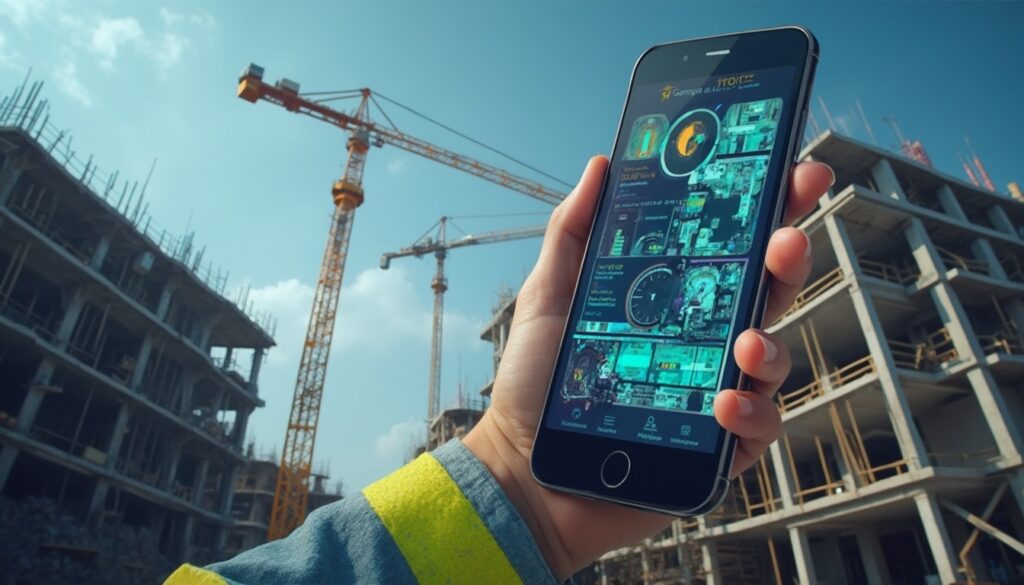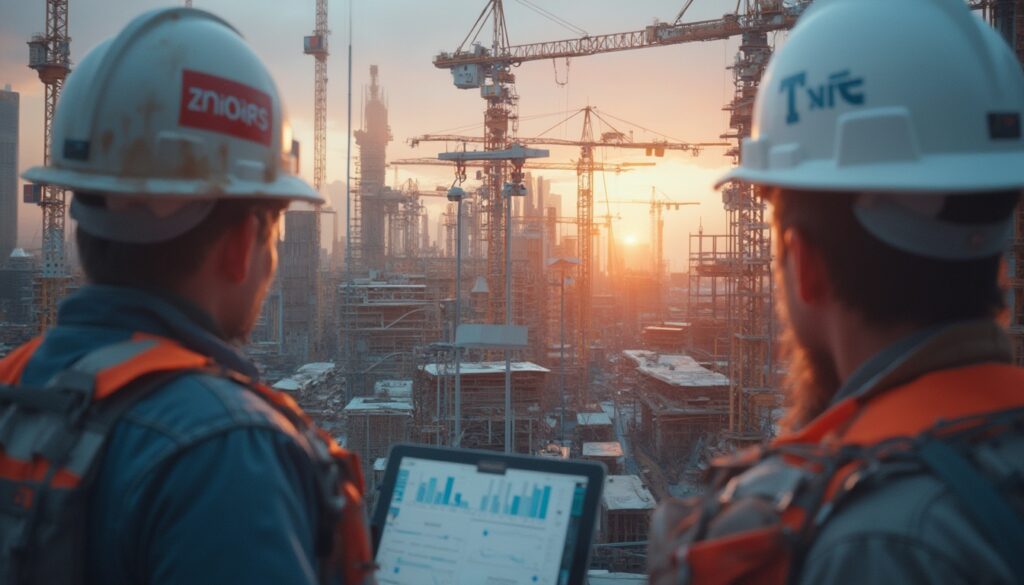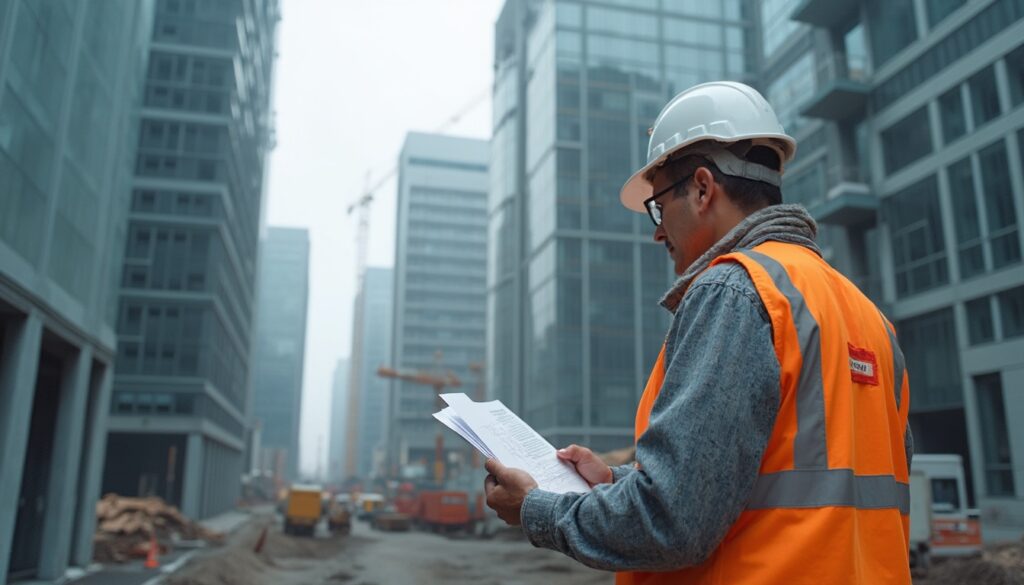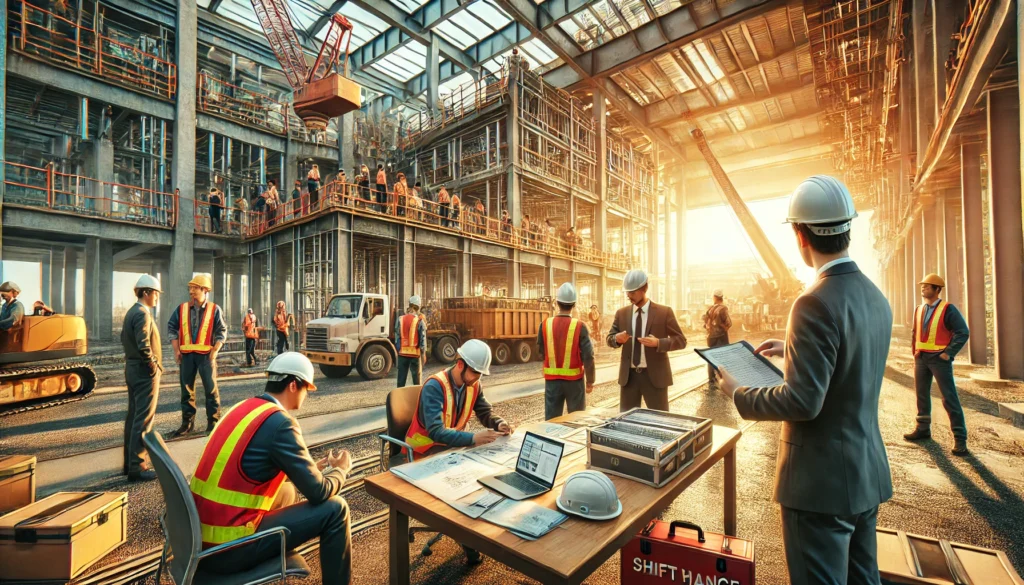Urban mega-projects: Here’s how to get your urban development projects on the path to success
The design of our cities faces huge challenges, but also equally big opportunities. Urban mega-projects play a key role, as they have the potential to sustainably transform urban spaces and significantly improve the quality of life for all of us. Because these ventures are so complex, it is essential to thoroughly understand the success factors and possible pitfalls. In this article, we want to show you how to successfully manage your projects with thoughtful planning approaches and fresh ideas. We at Valoon GmbH want to help you revolutionize communication processes and project management – especially in the construction industry – through simpler data collection and a better flow of information. Find out how, with our expertise and digital tools, you can efficiently manage even the trickiest projects. Just reach out to us for a personal consultation – we are happy to show you how we can turn your visions into reality.
- Key role for cities: Urban mega-projects sustainably transform urban spaces and improve quality of life.
- Mastering complexity: A deep understanding of the success factors and potential pitfalls is essential for these complex endeavors.
- Objective of the article: Presentation of thoughtful planning approaches and fresh ideas for project success.
- Valoon GmbH’s contribution: Support in revolutionizing communication processes and project management through simpler data collection and better information flow.
Why are urban mega-projects so important for our cities?
Urban mega-projects They are much more than just construction sites. They are real engines for urban development, capable of changing the appearance of a city and making it more attractive and economically stronger. According to a study, these projects often aim to create new housing, revitalize old industrial sites, or redesign entire neighborhoods. The expectations are of course huge: The goal is to create spaces that are not just functional, but truly livable, balancing social, ecological, and economic aspects. The true art lies in bringing all these various demands together and creating projects that genuinely benefit the community. For such initiatives to succeed, careful planning and professional project management are crucial. Project management. Only then can we achieve the goals and ensure positive effects that last a long time.
Our goal: A clear analysis and tips for your project
With this article, we want to shed light on the critical points in such projects and provide you with concrete tips for successful implementation. We will take a look at what these projects entail, the typical hurdles and conflicts, and introduce you to proven success factors and real-world examples. We will pay special attention to sustainability and innovation, the planning processes, and how to manage such projects, as well as the current trends in urban development. By combining theory with practical examples, we aim to show you how to cleverly plan, manage, and implement such projects. Of course, the use of digital tools also plays a role – like the ones we develop at Valoon GmbH. They can help improve communication and data handling in complex construction projects, thereby contributing significantly to the project’s success. We want to equip you to handle even the most challenging projects with confidence.What exactly are urban mega-projects, and what distinguishes them?
If you want to manage urban mega-projects successfully, you first need to understand what they actually are and what sets them apart. These projects are much more than normal construction initiatives and often have a massive influence on the cityscape and the quality of life for the inhabitants. Because of their complexity and scope, they require very specific approaches in planning and management. städtebauliche Großprojekte erfolgreich managen will, muss man erst einmal genau verstehen, was sie eigentlich sind und was sie auszeichnet. Diese Projekte sind nämlich viel mehr als normale Bauvorhaben und haben oft einen riesigen Einfluss auf das Stadtbild und wie gut die Menschen dort leben. Weil sie so komplex und umfangreich sind, braucht man dafür auch ganz spezielle Ansätze bei der Planung und im Management.
- Technical master planning as a foundation: Here, the technical rules and standards for the entire project area are established before moving on to detailed building plans. This ensures a coordinated development process.
- Early citizen involvement is worth its weight in gold: Involving the public from the start can help avoid disputes, improve plans, and ensure that people identify with the project. This is a critical point for successful mega-projects.
- . Plans create legal certainty:
Once development plans are legally binding, it gives investors and developers the necessary security. But until then, it is often a long journey with many approvals.
Urban mega-projects What are urban mega-projects? A clear distinction and typical characteristics are truly large endeavors that significantly alter the cityscape. According to the definition from the BBSR, these are projects with more than 500 apartments, over 1,000 residents, or covering an area of more than 10 hectares. They are typically characterized by thehigh complexity project management software for construction can be a great help to keep track of everything.
Where do we find such mega-projects? Practical examples
Urban mega-projects can be found in many areas, and they well illustrate what modern urban development needs to achieve today. This includes new residential neighborhoods like Rondorf Nord-West in Cologne, where not only apartments but also schools and daycare centers are being created. Or the Parkstadt Süd, also in Cologne, where new green spaces are being gradually established. The transformation of port areas, such as the Deutzer Hafen, into lively neighborhoods with apartments, offices, and leisure facilities is another typical case. Often, the goal is to increase urban density, while simultaneously enhancing the quality of life through beautiful open spaces and good connections to public transport. The major challenge in such projects is coordinating the many small sub-projects to ensure that a cohesive whole emerges at the end.
The A and O: Land use and development plans for mega-projects
Land use plans and development plans are super important tools in urban planning and have a massive impact on how these projects are managed. The land use plan outlines roughly how an entire city should develop. For such projects, this is often specified by more detailed development plans. These plans stipulate in a legally binding manner what and how can be built and which areas are available for construction. Good technical master planning, like for Cologne-Kreuzfeld, is an important basis before the official plans are made. It is crucial to involve citizens early and continuously. This creates acceptance and often improves the plans. However, because these planning processes are so complicated, many of such projects also take a long time.Tackling challenges: How to minimize conflicts in urban mega-projects
Of course, high expectations are often connected with them. But they also bring a significant amount of challenges and potential conflict. Therefore, it is crucial to remain realistic and to proceed with smart strategies, so that these projects become successful and meet the needs of the people in the city. Balancing ambitious goals with the often tricky reality requires management with a lot of sensitivity. städtebauliche Großprojekte knüpfen sich oft hohe Erwartungen. Aber sie bringen auch eine ganze Menge Herausforderungen und Zündstoff für Konflikte mit sich. Daher ist es super wichtig, realistisch zu bleiben und mit klugen Strategien vorzugehen, damit diese Projekte erfolgreich werden und zu dem passen, was die Menschen in der Stadt brauchen. Der Spagat zwischen ehrgeizigen Zielen und der oft kniffligen Realität verlangt ein Management mit viel Fingerspitzengefühl.
- Realistic goal setting: It is essential to have realistic expectations and proceed with smart strategies.
- Understanding the causes of conflicts: Conflicts often arise from a discrepancy between high expectations and reality, lack of transparency, or neglect of residents’ interests.
- Proactive conflict management: An active management style focused on dialogue and compromise is essential.
- Transparency and participation: Early and ongoing engagement of the public, along with open communication about project goals and impacts, are key to minimizing conflict.
Desire and reality: When mega-projects meet the ground truth
Cities naturally hope that such initiatives will make them more attractive, boost the economy, and improve the quality of life for residents and businesses. However, the reality often looks different, and those expectations are not always fulfilled, as also suggested by the publication IzR 11/12.2012 from the BBSR. Complicated planning processes, unexpected cost overruns, delays in construction, and disputes among different stakeholders can lead to less favorable outcomes than anticipated. Especially the challenge of reconciling the many decisions made by private investors is significant. Therefore, it is crucial to communicate openly about realistic goals and potential risks from the start. This prevents disappointments in such projects and helps to establish an effective controlling for mega-projects .
When mega-projects create conflict: Causes, consequences, and how to deal with them
Urban mega-projects can quickly cause trouble in the city. The reasons for this are varied: lack of transparency in planning and decision-making, residents’ interests that are overlooked, fears of displacement due to rising rents (gentrification), environmental issues during construction, or the feeling that costs and benefits are unfairly distributed. Such conflicts can lead to protests, legal action, and significantly slow down projects. The consequences can range from a poor reputation for the city and developers to the complete cancellation of entire initiatives. Therefore, active conflict management that focuses on dialogue and compromise is absolutely necessary. The question “” must always be answered with regard to the specific needs on the ground to ensure public support.
How to avoid disputes and gain support for your mega-project
To have as few conflicts as possible in urban mega-projects and to gain the support of the population, smart strategies are needed. A crucial point is to involve the public early and continuously . Information events, like the information point at the Deutzer Hafen project in Cologne, workshops, or digital opportunities for participation allow citizens to voice their concerns and ideas. Open communication about the project’s goals, its planning progress, and potential impacts builds trust. It is also important to clearly highlight the benefits of the project – for example, when affordable housing, new parks, or improved infrastructure are created. Considering “” can also help justify the project and gain acceptance. A Öffentlichkeit frühzeitig und immer wieder mit ins Boot zu holen. Infoveranstaltungen, wie der Infopoint beim Projekt Deutzer Hafen in Köln, Workshops oder digitale Möglichkeiten zur Beteiligung geben den Bürgern die Chance, ihre Sorgen und Ideen loszuwerden. Eine offene Kommunikation über die Ziele des Projekts, wie es mit der Planung vorangeht und was die möglichen Auswirkungen sind, schafft Vertrauen. Außerdem ist es wichtig, die guten Seiten des Projekts klar zu benennen – zum Beispiel, wenn bezahlbarer Wohnraum, neue Parks oder eine bessere Infrastruktur entstehen. Auch wenn man “” berücksichtigt, kann das helfen, das Projekt zu rechtfertigen und Akzeptanz zu finden. Ein guide for mega-projects can assist in implementing these strategies step by step.Identifying success factors: What distinguishes forward-thinking urban mega-projects
Ob städtebauliche Großprojekte becoming a success depends on many different factors. Studies and practical experiences show that certain approaches and conditions significantly improve the chances of good development. It is absolutely important to orient yourself to good examples and utilize scientific insights.
- Simple data collection: Your staff on the construction site can enter data directly via familiar messengers like WhatsApp. This is well received and saves training. Especially when many people need to be coordinated on large construction sites, this is a real advantage.
- All tasks in one place: All information and tasks are centrally collected and clearly structured. This ensures better overview and fewer misunderstandings. And this is crucial to meet timelines in complex endeavors.
- Smart reports in no time: With our intelligent reporting functions, you can quickly create photo documentation, measurements, and daily reports. This increases transparency and traceability and supports your controlling of mega-projects.
What makes new urban districts successful? Insights from the BBSR study
A BBSR study on large new construction projects has identified several important success factors for new urban districts that are also super relevant for such initiatives. For example, placing renewable energy at the top of the list and building energy- and land-efficient is crucial. Equally important are beautiful green and open spaces, which are simply good for quality of life. A good mix of social facilities such as childcare centers, schools, and shopping opportunities, as well as appealing design of buildings and public spaces, are additional keys to success. Good public transport connections are also essential. Most importantly, these new urban districts must be designed so that und sehr energie- und flächeneffizient baut. Genauso wichtig sind schöne Grün- und Freiflächen, die einfach gut für die Lebensqualität sind. Eine gute Mischung an sozialen Einrichtungen wie Kitas, Schulen und Einkaufsmöglichkeiten sowie eine ansprechende Gestaltung der Häuser und Plätze sind weitere Schlüssel zum Erfolg. Ganz entscheidend ist auch eine gute Anbindung an Bus und Bahn. Aber vor allem müssen neue Stadtviertel bei solchen Projekten so geplant sein, dass dort people of diverse backgrounds and financial means can live together and feel comfortable. This prevents groups from isolating themselves. These points are particularly important for construction companies handling mega-projects.
Learning from the best: Success stories and what we can take from them
In Germany, there are many examples of städtebauliche Großprojekte, which have gone very well and from which we can learn a lot for future projects. HafenCity in Hamburg, for example, is known for its vibrant mix of living and working, impressive architecture, and high sustainability standards. The French Quarter in Tübingen is a great example of compact building, car-free zones, and a strong sense of community. These projects clearly show that a clear vision, a city that takes the reins, and the courage to pursue new solutions are crucial. When looking closely at such examples – just as in the book “London – Geographies of a Global City” for international projects – it helps to recognize success recipes and transfer them to one’s own initiatives. The project manager for mega-projects plays a central role in this.
Ensuring quality: How concept awarding and urban developers can help
How land is allocated and how project development is organized have a huge impact on the quality of such initiatives. In the so-called concept awarding cities cannot simply sell land to the highest bidder but rather to whoever has the best concept. This makes achieving goals like affordable housing, new ideas for mobility, or special environmental standards much more attainable. Urban development companies or housing construction firms can also play an important role by actively taking on development and pursuing long-term urban development goals. They can help coordinate the often very complicated processes in these projects and ensure that the interests of all citizens are taken into account. A well-thought-out action plan for mega-projects is an essential foundation for this.
How Valoon can assist you with urban mega-projects:
Our software offers you concrete advantages for managing your initiatives:Sustainable and innovative: Here’s how we shape future-oriented neighborhoods
Sustainability and innovation are no longer just nice extras but a must for modern städtebauliche Großprojekte. Future-oriented neighborhoods must be ecologically, socially, and economically excellent and utilize new technologies to improve life and conserve resources.
- Smart City approaches: Utilization of digital technologies to enhance efficiency, sustainability, and quality of life in neighborhoods.
- Principle of circular economy: Focus on resource conservation, waste prevention, and material reuse.
- Innovative mobility concepts: Introduction of mobility hubs to create pedestrian-friendly and traffic-calmed zones.
- Collaborative implementation: Importance of partnerships between cities, businesses, and citizens for the realization of sustainable and innovative projects.
Smart City: How clever strategies and partnerships advance neighborhoods
With Smart City strategies, we aim to make our cities more efficient, sustainable, and simply more livable through digital technology. In such initiatives, it is often wise to take a project-based approach and develop and implement specific smart solutions tailored to each neighborhood. This could involve anything from intelligent electricity networks to innovative transport concepts to digital offerings for citizens. A good example is Vienna’s Smart City strategy, which is built on a strong collaboration between cities, businesses, and citizens. Such partnerships, involving various stakeholders, are incredibly important to pool the necessary knowledge and resources for new ideas in these projects. The digitalization in construction is, of course, a crucial factor here.
Everything in a loop: How neighborhoods can become more sustainable through the circular economy
The circular economy is becoming increasingly important in public early and continuously . The goal is clear: To use resources for as long as possible, avoid waste, and consume fewer new raw materials. The project ‘Wunne mat der Wooltz’ demonstrates this very well. Here, aspects of the circular economy are integrated into architecture, landscape planning, mobility, water management, and even social and economic areas. This might mean reusing building materials, designing buildings for easy repurposing, or establishing local material cycles. Such ideas naturally require a shift in thinking when planning and implementing such initiatives, but they have enormous potential for becoming more sustainable. Baumaterialien wiederverwendet, Gebäude so plant, dass man sie später leicht umnutzen kann, oder lokale Stoffkreisläufe aufbaut. Solche Ideen erfordern natürlich ein Umdenken bei der Planung und Umsetzung von solchen Vorhaben, aber sie haben ein riesiges Potenzial, um nachhaltiger zu werden.
Fewer cars, more life: Mobility hubs for pedestrian-friendly neighborhoods
A cool new idea to enhance mobility and quality of life in neighborhoods is the so-called mobility hubs. At these hubs, car traffic is consolidated at central locations on the edge or in the middle of the neighborhood. This allows for the creation of traffic-calmed or even car-free zones where pedestrians and cyclists have priority and where people enjoy spending time. Often, these mobility hubs also offer sharing options for cars, bikes, or e-scooters and provide good connections to public transport. This approach allows for better traffic control and helps make such projects more beautiful and environmentally friendly. When implementing such concepts, it is essential to plan early and closely examine what future residents and users will need in terms of mobility.Planning and management with insight: How to optimize governance for your mega-projects
For them to truly succeed, not only great plans are needed, but also clear structures for governance and effective tools. These projects are so complex, involve so many different people, and have such long-term impacts on the city – this poses significant demands on project control and management. städtebauliche Großprojekte wirklich ein Erfolg werden, braucht es nicht nur tolle Pläne, sondern auch klare Strukturen für die Steuerung und wirksame Werkzeuge dafür. Diese Projekte sind so komplex, es machen so viele verschiedene Leute mit und die Auswirkungen auf die Stadt sind so langfristig – das stellt echt hohe Anforderungen an die Projektsteuerung und das Management.
- Set clear goals: From the outset, establish measurable and realistic goals for your initiative.
- Bring everyone on board: Identify who is important and involve these individuals early and continuously.
- Keep an eye on risks: Examine what could go wrong and consider strategies to minimize these risks as much as possible.
Cleverly selling plots: How private investments fit into the overall picture of mega-projects
One of the biggest challenges in public early and continuously is reconciling the many decisions of private investors. Strategic land sales play a very important role in this. A dissertation from TU Hamburg-Harburg / HafenCity University Hamburg shows that the phase of land sales and how they influence project success is a truly critical point. It’s about selling land in a way that achieves urban development goals while simultaneously creating favorable conditions for private investors. This requires careful design of sales processes, setting clear quality requirements, and perhaps taking new avenues in awarding, like concept awarding. The city or municipality must become active here to ensure that such initiatives truly serve the common good. Grundstücke so zu verkaufen, dass die Ziele der Stadtentwicklung erreicht werden und gleichzeitig gute Bedingungen für private Investoren entstehen. Dafür muss man die Verkaufsprozesse sorgfältig gestalten, klare Qualitätsvorgaben machen und vielleicht auch neue Wege bei der Vergabe gehen, wie die Konzeptvergabe. Die Stadt oder Gemeinde muss hier aktiv werden, um sicherzustellen, dass solche Vorhaben auch wirklich dem Wohl aller dienen.
The city at the helm: How good leadership steers mega-projects towards success
The city or municipality has overall responsibility for how urban development unfolds. städtebauliche Großprojekte Therefore, functioning governance models are absolutely necessary to achieve the best outcomes for the project. This involves clearly setting goals and priorities, creating transparent decision-making processes, engaging in constant dialogue with all stakeholders, and maintaining effective project controlling. Reviewing how such projects have been managed in the past and adapting that to the specific needs of these initiatives is an important step toward improvement. It is also essential to find the right balance between what the city mandates and what private initiatives can deliver. Additionally, it’s worth exploring whether agile methods, like those in Ziele und Prioritäten klar festlegt, transparente Entscheidungswege schafft, ständig mit allen Beteiligten spricht und ein gutes Projektcontrolling hat. Sich anzuschauen, wie solche Projekte bisher gesteuert wurden, und das an die besonderen Bedürfnisse von solchen Vorhaben anzupassen, ist ein wichtiger Schritt, um besser zu werden. Dabei muss man auch die richtige Mischung finden zwischen dem, was die Stadt vorgibt, und dem, what private Initiativen leisten können. Und man sollte auch mal schauen, ob agile Methoden, wie beim agile mega-project management, could be a good fit.
Many minds, one goal: Integrating real estate knowledge and good management for urban planning
As these initiatives become increasingly complex, urban planning needs an approach that brings together many different experts. It is particularly important to incorporate knowledge from the real estate industry and about effective project governance. Understanding how local real estate markets operate and what motivates private investors is just as essential as having functioning governance mechanisms from the city. This holistic perspective, which is becoming increasingly important in urban research in this country, helps to plan these projects more realistically, manage risks better, and ensure that the city benefits in the long run. The use of BIM software can assist in this because it creates a shared data basis for all those involved in the project.Always on the move: Current trends in urban mega-projects
The world of urban mega-projects is constantly changing. This is due to factors like demographic change, new technologies, and an increasing awareness of sustainability. The current trends show us that significant shifts are occurring: Where building takes place, how dense and mixed it is, but also the ongoing challenge of how long everything takes.
- Full force for renewables: Planning solar panels, geothermal energy, and other sustainable energy sources.
- Economical with energy and space: Building compactly and energy-efficient structures preserves the environment.
- More green, more life: Creating parks, squares, and nature-friendly spaces for relaxation and promoting biodiversity.
Out of the city? New settlements on the outskirts and what this means for planning
After 1990, attention shifted. städtebauliche Großprojekte Yes, especially on old industrial or military sites right in the city. However, BBSR studies show that there has been a clear trend towards new settlements on the outskirts of the city in the last ten years, particularly in large cities. The reasons for this are that more and more people want to move to cities, land prices in the centers are skyrocketing, and there are simply larger, contiguous areas on the outskirts. This naturally presents city planners with new challenges: they must ensure that the landscape is not overdeveloped, provide good connections to the city center, and create beautiful, mixed neighborhoods with their own character on the outskirts. When planning these projects, special attention must be paid to factors such as environmentally friendly mobility and integration into the existing landscape.
More in less space: The trend towards dense, mixed neighborhoods
Another important trend in current public early and continuously is that building is becoming denser and more mixed. Newer neighborhoods often have more apartments on the same area and mix them more with businesses, schools, cultural offerings, and green spaces. This shift towards compact neighborhoods, where much is possible, fits well with the idea of the ‘city of short distances.’ The goal is to consume less space and create vibrant, colorful districts. The art lies in combining high density with a lot of quality of life and designing beautiful public squares and parks. For such projects, it means weighing up mass, how much open space there is, and how varied the uses are.
Why does it take so long? How we can speed up planning processes for large projects
Since the 1990s, the time required for such projects from idea to completion has more than doubled. This is because planning has become more complicated, more people want to have a say, and the requirements for implementation have increased. Especially in larger cities, it often takes even longer. These long time frames can create uncertainty, drive up costs, and make it difficult to respond to changes in the market. Therefore, we urgently need to make the planning processes simpler, grant permits more quickly, and employ better methods in project management. Digital tools, like those we offer at Valoon GmbH for the construction industry, can really help here. They improve communication and data exchange among everyone involved in these projects, thereby speeding everything up.Law and funding: How to pave the way for your urban planning large projects
Ob städtebauliche Großprojekte Success depends heavily on the laws and funding available. Planners, investors, and cities must be well-versed in these areas to ensure that the projects are legally sound and that funding is utilized effectively.
Building law as an aide: Special rules for implementing large projects
The special urban planning law in the Building Code (BauGB) provides us with important tools to städtebauliche Großprojekte implement. One crucial tool is the (§§ 165 ff. BauGB). This allows for quicker access to land that has not been utilized, lies fallow, or is misused. Thus, an area can be reorganized and developed according to urban development goals. This enables cities to acquire, develop, and then pass on land to individuals who want to build. For such projects, this is an important foundation to implement complicated developments in a coordinated manner and in line with significant urban planning goals—especially when it comes to correcting errors in urban development.
Funding from the state: Cleverly utilizing funding programs for large construction projects
To finance large construction projects, there are various funding programs from the federal and state governments. These programs often aim to support specific urban development goals, such as creating affordable housing, renovating buildings to save energy, adapting cities to climate change, or strengthening socially weaker neighborhoods. Examples include programs from KfW Bank or special funding from states. It is super important to inform yourself early and submit applications, to access these funds for such projects. You must know the funding guidelines exactly and prepare the applications professionally to maximize the chances of approval and ensure that the project is financially secure.
More leeway in planning: The idea of ‘Ilots’ as an opportunity for living and mixed neighborhoods
In the context of such projects, there is currently much discussion about how to make planning instruments more flexible. For example, there are calls to allow so-called ‘Ilots’ (which are like islands or blocks with their own rules) not only in commercial areas but also in residential or mixed neighborhoods within development plans (‘PAP nouveau quartier’). This could enable parts within large new neighborhoods to be designed more diversely and flexibly and thus better meet specific needs or new ideas. If planning becomes more flexible, it could help shorten planning and approval times for large construction projects while simultaneously increasing the quality and diversity of what is built, as tailored solutions for individual plots can then be found.Conclusion and outlook: Shaping the city of the future with successful large projects
Of course, städtebauliche Großprojekte they are complicated, but we absolutely need them to make our cities fit for the future. They give us the opportunity to respond to pressing issues such as the lack of housing, climate change, and the need for sustainable infrastructure. Whether these projects will be successful depends on many factors: from careful planning to open communication to the inclusion of new and sustainable ideas.
The most important points for your project planning in such endeavors
We have seen: For the success of public early and continuously it is incredibly important to involve the citizens early and thoroughly, to have clear governance by the city, and to be willing to collaborate with experts from different fields. Tools such as concept tenders, the formation of municipal development companies, and more flexible planning instruments can significantly improve the quality and acceptance of projects. Moreover, it is no longer just nice but absolutely necessary to consider sustainability topics such as renewable energy, circular economy, and smart mobility solutions. The fact that everything takes so long remains a challenge. We must address it with more efficient processes and digital tools. We at Valoon GmbH are here to help you improve communication and data management in your projects.
What to do now: Recommendations for politicians, planners, and investors on large projects
For them to truly succeed, not only great plans are needed, but also clear structures for governance and effective tools. These projects are so complex, involve so many different people, and have such long-term impacts on the city – this poses significant demands on project control and management. städtebauliche Großprojekte To be successful in the future, we must now tackle specific issues. Politics must provide reliable framework conditions and design funding programs in a way that they genuinely help. Planners should collaborate with various experts, pursue bold new ideas, and see citizen participation as an integral part of the whole process. Investors should not only focus on quick profits but also keep the long-term quality of urban development and sustainability in mind. A partnership at eye level between all stakeholders is key to getting the most out of such projects and creating amazing living spaces for tomorrow’s inhabitants. The use of project management software for construction can be a great help.
Looking ahead: How we utilize trends and innovations for sustainable urban development
The urban development of the future will continue to be shaped by exciting trends and new ideas. Digitalization, especially through BIM (Building Information Modeling), will further change the way we plan and build such projects. Issues such as resilience against climate change, the concept of sponge cities, and more biodiversity in the city will become increasingly important. Simultaneously, due to demographic changes and new lifestyles, we need flexible and adaptable living and working options. Such projects must anticipate these developments and incorporate new solutions to be successful in the long term. We at Valoon GmbH are your partner to tackle these complex tasks with smart software solutions. Discover for yourself how we can improve communication and project management for your initiatives. Contact us today for a personal consultation and successfully launch your project into the future. Request information now and learn more about our solutions at /contact.
How can Valoon simplify the communication for complex urban large projects with many field staff?
Valoon simplifies communication by allowing field staff to capture data and reports directly through familiar messaging services like WhatsApp . This information is collected and structured centrally, which significantly improves the flow of information between the construction site and the office and reduces misunderstandings.
What advantages does the WhatsApp integration of Valoon offer for data collection on large construction sites?
The WhatsApp integration allows for extremely simple and rapid data collection without the need for specialized software training. Employees use a tool they already know, which increases ohne spezielle Software-Schulungen. Mitarbeiter nutzen ein Tool, das sie bereits kennen, was die acceptance and reduces error rates. Photos, notes, and form data can be effortlessly transmitted.
How does Valoon help structure the information flood in urban large projects and keep track?
Valoon automatically transforms unstructured messenger communication into usable, structured project data . Through central task management and cloud-based project storage, you always maintain an overview of all relevant information and progress.
Does Valoon also support multilingual teams, which are often present in urban large projects?
Yes, Valoon has an automatic translation feature in over 50 languages. This eliminates language barriers and ensures that all team members, regardless of their native language, can communicate and collaborate effectively. What type of reports for the
Welche Art von Berichten für das project controlling in urban large projects can be created with Valoon?
With Valoon, you can easily and quickly create intelligent reports such as photo documentation, measurements, and daily reports. These reports provide current data for effective project controlling and transparent tracking of project progress.
Wie Does Valoon reduce the training effort for software for employees in the field on large construction sites?
As Valoon is based on the use of common messaging services that most employees are already familiar with, the training effort is drastically reduced. This allows for quick familiarization and immediate productivity of new team members without lengthy software training.








